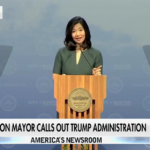Lately, there have been reports that the White House is taking a close look at the Smithsonian Institution’s educational materials, which brings up questions about keeping a fair balance between what really happened and political stories. This discussion is really about the administration’s push for something they call “patriotic education.” Though it might sound good, it’s made people wonder how American history should be taught, what parts are most important, and what might be ignored. As the country’s top museum and research center, the Smithsonian is right in the middle of this disagreement.
The Origins of the Push for ‘Patriotic Education’
The idea of “patriotic education” is not new. For decades, different administrations and political movements have argued about how American history should be taught in classrooms and showcased in museums. Advocates believe it fosters pride, unity, and appreciation for the sacrifices that built the country. Critics argue that it risks whitewashing historical injustices, silencing marginalized voices, and ignoring painful truths.
The recent White House involvement follows years of public debates over topics such as slavery, the civil rights movement, immigration, and America’s wars. These debates intensified after nationwide protests on racial justice, where many called for a fuller acknowledgment of systemic inequality. Against that backdrop, some political leaders began insisting that schools and cultural institutions were teaching children to “hate America.”
This climate gave rise to the latest push for patriotic education, with the Smithsonian being asked to review and potentially revise its materials.
Why the Smithsonian Matters
The Smithsonian Institution, often called the nation’s attic, is more than just a group of museums. It includes 21 museums, galleries, and a zoo, with a collection of over 150 million items, like fossils and space capsules. Its goal is to expand knowledge and share it, making it a key resource for teachers, researchers, and anyone interested in learning.
Because it’s so famous, the Smithsonian has a big influence on how we remember American history. Exhibits covering the founding fathers, civil rights, Native American culture, and military history not only present facts, but also shape how millions of Americans and international visitors view the U.S. Therefore, any political influence over how these stories are presented is a real concern. Some people think schools should focus on uplifting stories of heroes and wins. . One official said we should teach kids about the positive aspects of America, not just the negative ones.
Still, many history experts and teachers argue that hiding the truth isn’t a good idea for education. They believe you can be patriotic while being honest about the past Instead, it shows how the country has changed and tried to become better. If the Smithsonian changes its teaching materials, it could really have a big impact. Teachers often use what the Smithsonian offers—like lesson plans, online stuff, and exhibits that travel around—to make their classes better. So, if the Smithsonian changes how it talks about things or what it focuses on, it could change how millions of students learn history.
Some teachers are worried that this might cause people to avoid certain topics. One high school teacher said that If teachers feel they can’t talk about tough things like racism, students won’t be able to really think about and discuss history. But then again, some teachers are happy about getting more fair and balanced materials because it might make their classrooms less political. Right now, the Smithsonian hasn’t said exactly what will change in its exhibits or classes. Leaders say they’re still all about being correct and scholarly. At the same time, they know it’s important to inspire a sense of worth. Meanwhile, the White House keeps saying that we need to teach kids to love their country. They think it’s key to keeping everyone united.
What happens could change what museums show and how we talk about what it means to be American. Will kids learn a simple, good guy version of history? Or will they learn the real story of a nation’s messy, complicated path?
This is important. History isn’t just about what happened long ago—it affects what’s coming. How America teaches its story now will change how people see their country, their duties, and what they can do in the future. The White House’s look at Smithsonian content shows a bigger problem in the country: the conflict between loving your country and telling the truth about it. Others worry that it could leave out tough, but key, parts of history.The Smithsonian, a symbol of America’s story, has a tricky job. It needs to handle these pressures without messing up its purpose. If it can mix pride with honesty, that will decide what its exhibits look like and if American history is seen as believable.
In the end, maybe the best way to love your country is to face the past honestly while trying to reach its highest goals, not just blindly celebrating it.









